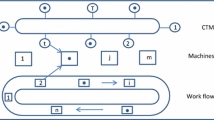Abstract
In traditional cell-formation problems, it is assumed that each part is developed on a single machine. However, in many realistic situations, the suitability of alternative machines for developing the same part feature is frequently vague. Therefore, the fuzzy relation is ideally suited to represent this vague and uncertain cell-formation problem. Furthermore, part-machine family formation problems are usually NP-complete. In this study, a genetic algorithm (GA) is used to deal with the problem. The aim of this study is to design a GA-based algorithm to solve the part-machine family formation problem in a fuzzy environment. The results of computational tests presented are very promising.
Similar content being viewed by others
References
Akin G, Cesswell SH, Goldberg JB, Vakharia J (1991) A Hamiltonian path approach to reordering the part-machine matrix for cellular manufacturing, Int J Prod Res 29(6):1081–1100
Balakrishnan J, Jog PD (1995) Manufacturing cell formation using similarity coefficients and a parallel genetic TSP algorithm formulation and comparison. Math and Comput Model 21(12):61–73
Ben-Arieh D, Lee SE, Chang PT (1996) Theory and methodology: Fuzzy part coding for group technology. Eur J Oper Res 92:637–648
Ben-Arieh D, Triantaphyllou E (1992) Quantifying data for group technology with weighted fuzzy features. Int J Prod Res 30(6):1285–1299
Boctor FF (1990) A linear formation of the machine-part cell formation problem. Int J Prod Res 29:343–356
Cheng CH, Gupta YP, Lee WH, Wong WF (1998) A TSP-based heuristic for forming machine groups and part families. Int J Prod Res 36(5):1325–1337
Chu CH (1997) An improved neural network for manufacturing cell formation. Decision Support Syst 20:279–295
Chu CH, Hayya JC (1991) A fuzzy clustering approach to manufacturing cell formation. Int J Prod Res 29(7):1475–1487
Gindy NNZ, Ratchev TM, Case K (1995) Component grouping for GT applications – a fuzzy clustering approach with validity measure. Int J Prod Res 33(9):2493–2509
Gungor Z, Arikan F (2000) Application of fuzzy decision making in part-machine grouping. Int J Prod Econ 63:181–193
Holland JH (1975) Adaptation in natural and artificial systems. University of Michigan Press, Ann Arbor
Hwang H, Sun JU (1996) A genetic-algorithm-based heuristic for the GT cell formation problem. Comp Industrial Eng 30(4):941–955
Kumar CS, Chandrasekharan MP (1990) Grouping efficacy: a quantitative criterion for goodness of block diagonal forms of binary matrices in group technology. Int J Prod Res 28:233–243
Kuo RJ, Chi SC, Teng PW (2001) Generalized part family formation through fuzzy self-organizing feature map neural network. Comp Industrial Eng 40:79–100
Leem CW, Chen JJ (1996) Fuzzy-set-based machine-cell formation in cellular manufacturing. J Intell Manufact 7:355–364
Liao TW (2001) Classification and coding approaches to part family formation under a fuzzy environment. Fuzzy Sets Syst 122:425–441, 2001
Moon C, Gen M (1999) A genetic algorithm-based approach for design of independent manufacturing cells. Int. J Prod Econ 60–61:421–426
Onwubolu GC, Mutingi M (2001) A genetic algorithm approach to cellular manufacturing systems. Comp Indust Eng 39:125–144
Pai PF, Lee ES (2001) Parts clustering by self organizing map neural network in a fuzzy environment. Comp Math Appl. 421/2:179–188
Seifoddini H (1989) A note on the similarity coefficient method and the problem of improper machine assignment in group technology applications. Int J Prod Res 27(7):1161–1165
Su CT (1995) A fuzzy approach for part family formation. Proceedings of The IEEE Industry Application Society 30th Annual Meeting, Orlando, Florida, October:289–292
Szwarc D, Rajamani D, Bector CR (1997) Cell formation considering demand and machine capacity. Int J Prod Res 13:134–147
Tsai CC, Chu CH, Barta AT (1994) Fuzzy linear programming approach to manufacturing cell formation. IEEE World Congress on Computational Intelligence 2:1406–1411
Xu H, Wang HP (1989) Part family formation for GT applications based on fuzzy mathematics. Int J Prod Res 27(9):1637–1651
Yasuda K, Yin Y (2001) A dissimilarity measure for solving the cell formation problem in cellular manufacturing. Comp Indust Eng 39:1–17
Zhang C, Wang H (1992) Concurrent formation of part families and machine cells based on the fuzzy set theory. J Manufact Syst 11(1):61–67
Author information
Authors and Affiliations
Corresponding author
Rights and permissions
About this article
Cite this article
Pai, PF., Chang, PT. & Lee, SY. Part-machine family formation using genetic algorithms in a fuzzy environment. Int J Adv Manuf Technol 25, 1175–1179 (2005). https://doi.org/10.1007/s00170-003-1944-z
Received:
Accepted:
Published:
Issue Date:
DOI: https://doi.org/10.1007/s00170-003-1944-z




